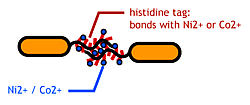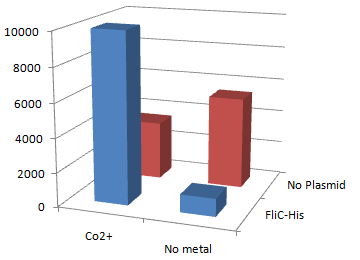Chiba/Engeneering Flagella
From 2007.igem.org
(→Results&Discussion) |
(→Results&Discussion) |
||
| Line 69: | Line 69: | ||
1.Stickiness check | 1.Stickiness check | ||
[[Image:Beads-Adsorption Colony-Number.jpg|frame|left|fig2. Strain GI826(''⊿fliC'',''⊿motB'').]]<br clear="all"> | [[Image:Beads-Adsorption Colony-Number.jpg|frame|left|fig2. Strain GI826(''⊿fliC'',''⊿motB'').]]<br clear="all"> | ||
| + | [[Image:|frame|left|fig2. Strain GI826(''⊿fliC'',''⊿motB'').]]<br clear="all"> | ||
*In the presence of Co<sup>2+</sup>Histidine tag,beads | *In the presence of Co<sup>2+</sup>Histidine tag,beads | ||
Co<sup>2+</sup>Histidine Tagの存在よって大腸菌がビーズに吸着している. | Co<sup>2+</sup>Histidine Tagの存在よって大腸菌がビーズに吸着している. | ||
| Line 77: | Line 78: | ||
<!-- | <!-- | ||
*'''FliC(hisなし)はないんでしたっけ?古''' | *'''FliC(hisなし)はないんでしたっけ?古''' | ||
| - | ** | + | **ないです。今から取るか否か、というところです。結果が出るのはwikiの締め切りの後(明日の昼)です。Wikiにはどのように考察、記載するべきでしょうか?TominagaBeads-Adsorption Colony-Number.jpg |
*'''考察も書いたら? なぜコバルトがニッケルより良いのか?一般的にニッケルよりコバルトの方が結合力が強いことが知られてて,FilC-hisに関してもそれは変わらないみたいな・・・by tashiro''' | *'''考察も書いたら? なぜコバルトがニッケルより良いのか?一般的にニッケルよりコバルトの方が結合力が強いことが知られてて,FilC-hisに関してもそれは変わらないみたいな・・・by tashiro''' | ||
**Beadsとヒスチジンの反応では、Co2+が中心に位置し、ヒスチジンの空間的位置に対する要求性が厳密になっています。連続するヒスチジンや空間的に適切に配置する隣接ヒスチジンのみがこの反応中心でコバルトに結合します。Ni2+ではこのような空間的要求性はあまり厳密ではありません。このため、Ni2+つきのBeadsを用いた場合、His タグ融合タンパク質以外に存在するヒスチジンも結合してしまいます。 | **Beadsとヒスチジンの反応では、Co2+が中心に位置し、ヒスチジンの空間的位置に対する要求性が厳密になっています。連続するヒスチジンや空間的に適切に配置する隣接ヒスチジンのみがこの反応中心でコバルトに結合します。Ni2+ではこのような空間的要求性はあまり厳密ではありません。このため、Ni2+つきのBeadsを用いた場合、His タグ融合タンパク質以外に存在するヒスチジンも結合してしまいます。 | ||
Revision as of 03:44, 27 October 2007
|
Introduction | Project Design ( 1.Affinity Tag | 2.Communication Module | 3.Size Control ) | Making Marimos | Our Goal |
Stickey Tags
Our Aim
To make stickey hands on E.coli, we focused on their flagella that are located outside the cells. We used the following mechanisms:
- Display sticky peptides in flagellar filament.
- His-tag. The imidazole group in histidines make a complex with metal ions.
We combined these two and made a His-tagged flagella in the hope to stick them together via metal ions.
[http://www.npn.jst.go.jp/index.html About flagella]
E.Coli have 5-10 flagella. The flagella is used for swimming and for chemotaxis; the bacteria run when they find attractant, tumble when there is a repellent.
E.coli flagella consist of three parts: a basal body, a hook, and a filament. The filament of E.Coli is a rigid, helical, and cylindrical structure which is 10-15μm long and 23nm thick in diameter. It is built from ~20000 subunits of a ~55kDa single protein, FliC. FliC has three domains, D1,D2,D3; although D1 and D2 are needed for the formation of the functional flagellar filament, D3 domain which sticks outside of the fillament are not essential[1].
"Variable" FliC D3 domain
It is reported that the proteins up to 49.4kDa could be displayed on the cell surface of E.Coli using flagellin fusion protein.[2]
References
- Kuwajima, G. et al.: J. Bacteriol., 170, 3305-3309 (1988).
- Ezaki, S. et. al.: J. Ferment. Bioeng., 86, 500-503 (1998)
About Histidine Tag
See [http://en.wikipedia.org/wiki/His-tag wikipedia article].
Experiments
Making FliC-his gene
- We inserted the short peptide with six histidine (“His-Tag”) into the fliC D3 domain.
Checking the "Stickiness": Beads Adsorption
Purpose
Confirm that the his-tags are displaied on the flagella and are capable of binding to Co2+- or Ni2+- surface.
Samples
- JW1908(⊿fliC strain) transformed with
- pUC19-fliC-his
- no plasmid
- GI826(⊿fliC⊿motB strain) transformed with
- pUC19-fliC-his
- no plasmid
Testing Procedure
- pUC19-FliC-His was transformed to JW1908(fliC) and GI826(fliC motB).
- Grown to stationary phase
- Culture suspended with Dynabeads (Metal-IDA), allowing to the affinity adsorption
- Beads washed with a phosphate buffer (x4)
- E" coli" detached from beads by adding imidazole then spreaded on agar plates.
- The number of the colonies on resultant plates.
Results&Discussion
1.Stickiness check
[[Image:|frame|left|fig2. Strain GI826(⊿fliC,⊿motB).]]
- In the presence of Co2+Histidine tag,beads
Co2+Histidine Tagの存在よって大腸菌がビーズに吸着している.
- Ni2+よりもCo2+のほうがfliC-his存在下でより吸着している.
- Ni2+よりもCo2+のほうがfliC-hisの有無で吸着の差が大きい
- The number of colony dramatically decreased with out Co2+ or FliC-His plasmid.
2.Strainの比較
- この実験結果から言えることは何ですか?それと、上の実験結果との比較は?byとよたろ
3.金属イオンの比較




